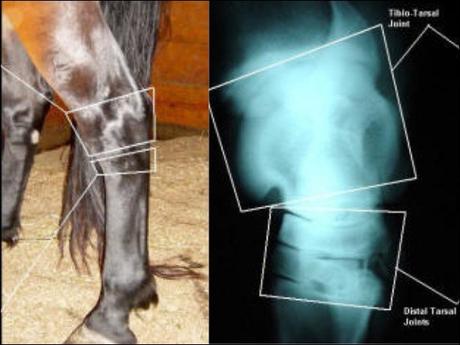Abstract
The Hock joint in the horse is a complex joint and is used to generate power to jump and to sit. The hock joint is prone to injury and degeneration. As the weight of the body of a horse puts pressure on joints. Thus the long-term pressure on joints or some infection may lead to the deprived status of joints. The weight of a horse's body puts a lot of pressure on its joints. Healthy joint cartilage can withstand this pressure, but long-term inflammation damages the cartilage and other joint tissues. The loss of cartilage in arthritic joints results in impaired function. Our ancient classical texts have ample episodes of our beloved friends and athletes. We all heard about Maharana Pratap's Chetak, an Epitome of Love and Valor, an obedient friend who fought for his rider till its last breath.

Introduction
The horse's hock is composed of 10 bones and 4 joints and is equivalent to the ankle of a human on the basis of evolution. These bones and joints are connected and supported by several ligaments. The upper part of the hock joint is formed by Tarso crural joint (TCJ), which is the largest joint with a ball and socket mechanism. It is a high-motion joint due to its greatest movement range. The other joints are PIT (proximal intertarsal), DIT (distal intertarsal), and tarsometatarsal (TMT) joint. These 3 joints act as low-motion joints and shock absorbers as well. The anatomy of the Hock joint is important to understand as to mark which part of the joint is affected the most. Horses of all disciplines can suffer from this problem as they always work heavily on the hind. Thus this is a brief about the general anatomy of the Hock joint of horses and later we will discuss the disease of the Hock joint with their ayurvedic approach to management. Let's read
Clinical features
- Pain in the Hock joint
- Loss of performance
- Lameness which can be intermittent
- Swelling
- Feeling of heat in the joint
- Difficulty in going downhill
- Feeling of lower back pain for compensation for hocks
Diseases associated with the hock joint
The following are the diseases associated with the hock joint in horses. We will discuss a few of the diseases here in this article
1. Bog spavin
Bog spavin is associated with tibiotarsal joint swelling of the hock of a horse. The joint of the horse becomes distended by synovial fluid. In younger horses, Bog spavin is caused by the defective tibiotarsal joint whereas in mature and old horses it is due to joint capsule chronic strain. The general causes include synovitis, joint degeneration, and regular/long-term strain of the capsule of the joint. There are no such significant changes in bone status in bog spavin. Trauma, infection, and the congenital joint defect can be the other underlying causes that may cause Bog spavin. In some horses swelling of the joint is also observable with the middle back surface of the hock. The bog spavin indicates that the horse is suffering from joint disease. The lameness may or may not be present, but in case of a heavy workload, the lameness may be seen. X-rays can be done to find out any change in the structural status of the joint.
2. Bone spavin
Bone spavin is the growth of the bone in the lower hock joint of the horse. The most possible causes of bone spaviness are cartilage compression, uneven loading, dressage, and Standardbred racing. It is a degenerative and non-septic type of arthritis. It is the basic lameness of hindlimb and is seen mainly in ponies and older horses as well. The lameness can be moderate to severe and can be associated with one or both joints. The lameness can range from mild stiffness with toe dragging to quite severe. Bone spavin is osteoarthritis and thus a degenerative condition of the bones and joint cartilage. The loss of cartilage gradually is the reason for the lameness.
3. Curb
Curb can be simply defined as collective injuries associated with soft tissues of the long plantar regions. The basic cause behind the curb is strain. There is associated thickening of the plantar tarsal ligament that runs down the back of the hock. The cause is typically strain. The other possible causes are falling, jumping, or pulling. The poor conformation of the hock joint increases the chances to develop the conditions. So the swelling in the distal lateral hock region area is the curb. This ligament may become inflamed and thickened after falling, slipping, jumping, or pulling. The condition is most common in Standardbreds, in which poor conformation of the hock makes the horse more prone to develop the condition. When we observe the horse from any side we can observe an enlargement or protrusion over the bone 10 cm below the hock point. A newly formed curb can show inflammation and lameness. Chronic curb may not show much lameness. The horse stands and favours the limb with the heel elevated. In cases of chronic curb, there is rarely any lameness or pain.
4. Osteochondritis dessecans (OCD)
Osteochondritis is a problem of abnormal joint development. This is a progressive condition associated with pain and inflammation. In this condition due to abnormalities of bone and cartilage, small fragments may result in breaking off and seen floating around/inside the joint. OCD is generally seen in young horses and foals. The other causes are nutritional issues, hormonal imbalances, or trauma due to overexertion. It is a type of developmental disorder.
5. Osteoarthritis (OA)
OA arises production of additional bone, due to additional bone and arises in the lower hock. Due to new bone formation, joint movement is restricted with pain and lameness. Horses who are involved in high-intensity workouts are more prone. Other associated factors for OA are poor conformation such as cow hock (conformational deformity of tarsals). Although it is also evident that horses undergoing low levels of workout may also suffer.
The ayurvedic aspect of horse hock diseases
Pashu chikitsa in Ayurveda shows the extension of Ayurveda. It is the developmental work done by Acharayas by virtue of their intellect that is always commendable. The origin of Pashu chikitsa and its development shows an association between humans and animals. Ancient texts are loaded with information about animal care. Sandhi roga in horses is prevalent due to the vitiation of doshas, especially the Vata dosha. Excessive exertion leads to an increase in the Vata dosha and reduced Kapha lead to the degreasing of the joints. The aggravated Vata causes pain and leads to the deprived status of the hock joint. The care of an animal by humans and vice versa shows our rich culture and high moral values. Planet ayurveda is following the principles of Ayurveda for the well-being of creatures, humans as well as our beloved pets.
Herbal remedies by Planet Ayurveda for horse hock diseases
Planet Ayurveda is a GMP-certified hub for the manufacturing of best-quality herbal remedies. The prime motive and ambition of Planet Ayurveda are to promote Ayurveda in each and every household of the world. We care for the pets because of the love and the companionship and want pet parents to prefer more herbal ways rather than synthetic herbs. Below are the herbs for the management of hock joint diseases in horses
Product List
- Yograj guggul
- Joint aid plus
- Boswellia curcumin
- Ashwagandha cap


Brief explanation
1. Yograj guggul
Yograj guggul is a polyherbal formulation having Commiphora mukul, Cyperus rotundus, Plumbago zeylanica, Emblica Officinalis, Terminalia bellirica, Terminalia chebula, Piper longum and many more as the chief ingredients. Yograj guggul helps to relieve the pain and inflammation in the body. It is helpful to manage the autoimmunity conditions in the body. Thus yograj guggul has the ability to counter the issues of pain. It helps to prevent the status of excessive pain due to Vata pacifying properties.
Dosage- 6 tablets twice daily.
2. Joint aid plus
Joint Aid plus of Planet Ayurveda is a natural formulation of Planet Ayurveda having Nirgundi (Vitex negundo), Shallaki (Boswellia serrata), Guggul (Commiphora mukul), Sonth (Zingiber officinale), Ashwagandha (Withania somnifera) as a chief ingredient. This formulation is useful for the better status of joints in horses. The Vata pacifying properties of the added herbs are used to reduce joint pain and have good results in the diseases associated with hock joints in horses.
Dosage- 4 caps twice daily.
3. Boswellia curcumin
The Boswellia Curcumin of Planet Ayurveda is a herbal formulation loaded with pure extract of Boswellia and Curcumin. This herbal formulation is able to manage the conditions associated with inflammation in the body. Boswellia itself is an analgesic and curcumin has anti-inflammatory properties. Boswellia curcumin also helps to prevent aggravated inflammation. Very useful anti-inflammatory supplement and helps to reduce the pain and swelling in the hock joint.
Dosage- 4 caps twice daily.
4. Ashwagandha cap
The chief ingredient of the Ashwagandha capsule is the standardised extract of Ashwagandha (Withania somnifera). Ashwagandha is known to reduce inflammation and act as a pain reliever. The presence of Withanolides in ashwagandha helps to reduce inflammation. Also ashwagandha acts as a powerful analgesic which is evident to soothe the nervous system and reduce pain as well. Ashwagandha is also denoted as the scent of a horse and is referred to as increased strength as well.
Dosage- 4 caps twice daily.
Conclusion
Horses are prone to hock diseases due to long-term exertion throughout their whole life. Certain factors like joint defects, infections, and poor posture are the leading causes. The herbal remedies of Planet Ayurveda are helpful to manage the status of horses, our friends, and riders. It is our duty to inform the horse masters about the herbs for disease-free riders. Herbs promote long and disease-free life and prevent pets from the side effects of synthetic herbs.

